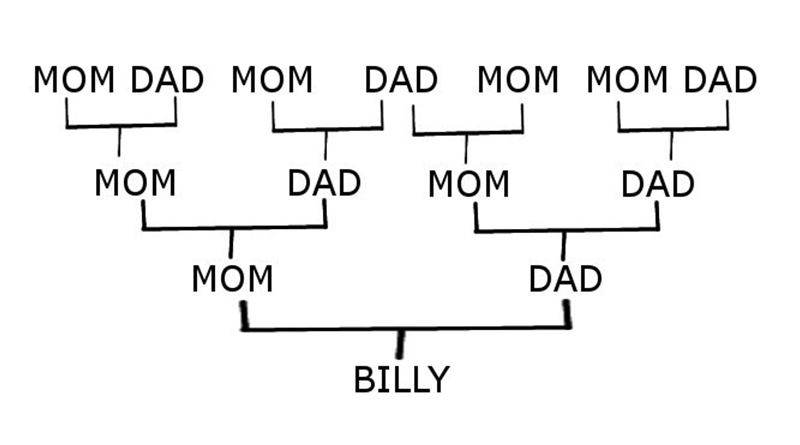
Why we don't have infinite ancestors
 Remember the Simpsons episode Lisa the Simpson? A load of Simpson relatives turn up at the house, the men looking like Homer and the women looking like Lisa (though not Marge or Bart, for some reason). It's like the Simpsons from a parallel universe.
Remember the Simpsons episode Lisa the Simpson? A load of Simpson relatives turn up at the house, the men looking like Homer and the women looking like Lisa (though not Marge or Bart, for some reason). It's like the Simpsons from a parallel universe.
I think that, in reality, relatives are more genetically diverse than this. But to think that our relatives are somewhere out there - are they like us? What are their lives like? It's interesting.
Let's get on to the point of this post: family trees.
The complexity of family trees can be explained because of 2 rules:
- Everyone has 2 parents - a mother and a father
- Each person (technically each couple) can have more than one child
Let's take young Billy as an example.

Billy has 2 parents, according to Rule 1. So let's respect this rule and give him a mom and a dad.

Great, we've satisfied the rule. But wait! The rule states that everyone has 2 parents. This must include the new people we've added, Billy's mom and dad. So let's draw his mom's parents and dad's parents in too.

These new additions are Billy's grandparents. To his grandparents, Billy is their grandson. The word 'grand' is used if we go up or down 2 tiers on the family tree. (Sorry if this sounds a bit patronising so far).
If we moved up or down 3 tiers on a family tree, we would be using the word great as well as grand. Hence, great-grandparents, and great-grandson. And for every tier we move after that, we add an extra great. So, great-great-grandparents, or great-great-great-great-great-great-great-great-great-great-great-great-grandparents if you're looking 14 tiers back.
Each tier up, we have double the amount of people. This is an example of exponential growth - 1, 2, 4, 8, 16, etc. In theory we would end up with infinity people on our last tier! This isn't possible, as we know that Earth isn't capable of sustaining an infinite number of organisms. There wouldn't be enough room for one thing. And do you remember being told that there are more people alive today than there are dead? Apparently we outnumber our ancestors. But rule 1 states, everyone must have 2 parents. Every 1 must have 2 on the tier above it.
What happens is a certain amount of imbreeding occurs. This isn't your slack-jawed yokel style of imbreeding where you marry your cousin. This is a watered down version where people are getting off with people they are only very distantly related to. Hey, we're all related to each other, if you only go back far enough on your family tree.
Let's see how this works.

Look at what has happened here. In the 1920's or whenever, one of Billy's great-grandfathers managed to score with 2 women (what a legend) and got both pregnant. Not uncommon in real life. Then, in the 1970's, Billy's mom and dad met for the first time and fell in love - not knowing, nor ever knowing, that they share a granddad (he died of an STD). In reality, when this kind of accidental imbreeding happens, the tier at which the 2 people are related is much higher up, perhaps at tier 10, or tier 15. I simply couldn't be arsed to draw that many tiers though.
The point is this. Note that for Billy's grandparents, rule 1 is being obeyed - they each have 2 parents. But, the number of parents totals 7 - one parent is acting as 2 parents. Hence, the growth between tiers is no longer exponential - it's 1, 2, 4, 7...
If we took this further we may expect a line of numbers like -
Look at tier 4. As we've seen, it didn't meet our expectations that there would be 8 ancestors - there were only 7. We saw that our number of ancestors doesn't increase exponentially with each tier.
Now look at tier 12. There are actually less ancestors in this tier than the tier before it. And tier 13 has less ancestors again. This may be going against our sensibilities that we get a greater number of ancestors each time we go further back on our family tree. (But remember, this would be impossible as Earth can't sustain infinite ancestors). In fact, at a certain point on each of our family trees, you begin to get less ancestors each time you go back. And at some point, really far back, you will have only 2 ancestors. Amazing, huh? I myself can't quite believe it. You would have to go really far back though. Perhaps millions of years, and hundreds of thousands of tiers. You definitely wouldn't be able to do it by going just just a few dozen tiers back, as I suggested in the table above. It's because we're so genetically diverse - imbreeding occurs at tiers which are quite far apart, instead of after just 3 tiers like in my model.
Next time we'll look at rule 2: Each person or couple can have more than 1 child, i.e. brother and sisters. (Note from me 4 years later: I don't think I actually did ever get round to doing this "next time" post. Sorry, readers.)


Leave a comment